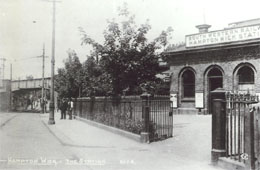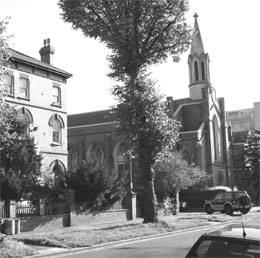Hampton Wick - Then and Now
Hamlet at the end of Kingston Bridge disrupted by the arrival of the railway and trams.

Hampton Wick enjoys a strategic position at the Middlesex end of Kingston Bridge; all the early roads radiated from the end of the bridge as through roads to other places. It was, however, part of Hampton until 1831 but was semi-autonomous long before then. In fact the community was frequently in dispute with Hampton, particularly about the apportionment of income from parish charities: there were long-running legal proceedings. The opportunity to separate from Hampton parish came in 1831 when St Mary's Church, now inadequate for the growing population, was rebuilt. The village became a separate parish and a new church dedicated to St John the Baptist (below) was built.

Kingston Bridge was rebuilt and opened in 1828 and nearly 20 properties in Hampton Wick were affected: many had to be demolished for the new approach roads. In 1865 schools were built for boys and girls in High Street and they were later extended. Between 1861 and 1863 the railway line from Twickenham to Kingston was cut through the village and another 20 houses had to be demolished.

In 1863 Hampton Wick was able to make the final break with Hampton when it became the first of the local areas to form a Local Board. This terminated local government control from Hampton. A library with Council offices above was built next to the schools in High Street.

There was further disruption to the village in 1902 when tramlines were laid and the road widened. This required the demolition of 21 buildings - some opposite the Swan public house and the rest opposite what is now the old library in High Street. New buildings were erected 20 feet (6 metres) further back. Since then the old school buildings have been replaced by an office block. Old Bridge Street, once packed with cottages, was mostly demolished in the 1960s and has been redeveloped.



